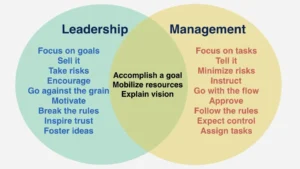Introduction: Separating Leadership from Management
Separating Leadership from Management can have detrimental effects on organizational culture. Although leadership and management are distinct roles, they are closely intertwined and exert significant influence on shaping the culture within an organization. This article examines the potential impacts of separating leadership from management and emphasizes the importance of integrating these functions to maintain a strong and cohesive organizational culture.
One of the primary consequences of separating leadership from management is the lack of vision within the organization. Leaders are responsible for establishing the organization’s long-term goals and vision. However, when leadership is disconnected from management, managers may become preoccupied with day-to-day operational tasks, losing sight of the broader vision. Consequently, a sense of direction may be compromised, leading to a diluted organizational culture.
Effective communication is crucial for cultivating a robust organizational culture. Leaders typically play a vital role in communicating the organization’s values, mission, and objectives to employees. When leadership and management are separated, communication breakdowns can occur, resulting in misalignment and confusion among employees. This breakdown in communication channels hampers the establishment of a cohesive culture.
Another significant impact of separating leadership from management is inconsistent decision-making. Leaders often make strategic decisions based on the organization’s values and long-term goals. However, managers who solely focus on operational tasks may prioritize short-term objectives or the specific needs of their departments. Consequently, decision-making becomes fragmented, leading to inconsistencies and a disjointed organizational culture that does not align with the overall vision.
Leaders are instrumental in fostering a culture of growth and development within an organization. They inspire and motivate employees to reach their full potential. However, when leadership is detached from management, managers may prioritize completing tasks over employee development. As a result, the organizational culture stagnates, and employee engagement declines.
In today’s rapidly changing business environment, organizations must be adaptable to stay competitive. Leaders typically guide the organization through change and encourage innovation. However, when leadership and management are disconnected, managers may resist change or lack the authority to drive necessary adaptations. Consequently, the organization’s ability to evolve is hindered, and its culture is compromised.
To maintain a strong and cohesive culture, it is crucial to integrate leadership and management functions. This can be achieved through various measures, such as providing managers with leadership training. By equipping managers with the necessary skills, knowledge, and mindset, they can effectively fulfill their leadership responsibilities alongside their managerial tasks.
Fostering open communication channels is another key aspect of integrating leadership and management. Ensuring that information flows freely and transparently throughout the organization promotes alignment and reduces confusion among employees. Regular communication from leaders regarding the organization’s values, mission, and objectives helps establish a shared understanding and a cohesive culture.
Additionally, aligning decision-making processes with the organization’s vision and values is essential. Managers need to consider the long-term goals and overarching vision when making operational decisions. By aligning their decision-making with the organization’s broader objectives, managers contribute to the establishment of a consistent and unified culture.
Conclusion
Separating Leadership from Management can undermine organizational culture. The lack of vision, communication breakdowns, inconsistent decision-making, limited employee development, and reduced adaptability are among the consequences of this separation. To foster a strong and cohesive culture, organizations must integrate leadership and management functions. By providing leadership training, promoting open communication, and aligning decision-making processes, organizations can cultivate a culture that encourages growth, collaboration, and long-term success.
FAQ
Q: What is the difference between leadership and management?
A: Leadership and management are distinct roles with different focuses. Leadership involves setting a vision, inspiring and motivating others, and guiding the organization towards its goals. It emphasizes long-term planning, innovation, and strategic decision-making. On the other hand, management involves organizing, coordinating, and overseeing day-to-day operations to achieve specific objectives. It focuses on efficient resource allocation, problem-solving, and ensuring tasks are completed effectively. While they have unique responsibilities, leadership and management are interdependent and both contribute to shaping the organizational culture.
Q: How does separating leadership from management affect organizational culture?
A: Separating leadership from management can compromise organizational culture in several ways. It can lead to a lack of vision, as managers may focus solely on operational tasks without a clear understanding of the broader goals. Communication breakdowns can occur, resulting in misalignment and confusion among employees. Inconsistent decision-making may arise, as managers prioritize short-term objectives over the organization’s long-term vision. The lack of emphasis on employee development can lead to a stagnant culture and decreased engagement. Furthermore, reduced adaptability may hinder the organization’s ability to evolve and compromise its culture.
Q: Why is effective communication important for organizational culture?
A: Effective communication is vital for a strong organizational culture. It ensures that employees understand the organization’s values, mission, and objectives. Clear communication promotes alignment, reduces misunderstandings, and fosters a sense of unity and shared purpose. It enables employees to make informed decisions and feel connected to the organization’s goals. Additionally, open communication channels encourage feedback, collaboration, and the exchange of ideas, driving innovation and positive cultural dynamics.
Q: How can integrating leadership and management functions benefit organizational culture?
A: Integrating leadership and management functions can have several benefits for organizational culture. By providing leadership training to managers, they gain the skills and mindset needed to fulfill their leadership responsibilities alongside their managerial tasks. This leads to a more cohesive and aligned approach to decision-making and goal-setting. Fostering open communication channels ensures that information flows transparently throughout the organization, promoting a shared understanding and reducing confusion. Aligning decision-making processes with the organization’s vision and values establishes consistency and unity. Ultimately, integrating leadership and management functions helps create a culture that promotes growth, collaboration, and long-term success.
Q: How can organizations foster employee development and engagement?
A: Organizations can foster employee development and engagement by providing opportunities for growth and learning. This can include offering training programs, mentoring initiatives, and career development paths. Recognizing and rewarding employee achievements and contributions also promotes engagement. Creating a supportive and inclusive work environment where employees feel valued and empowered contributes to their development and engagement. Regular feedback and performance evaluations help identify areas for improvement and provide guidance. Additionally, encouraging work-life balance, promoting a positive organizational culture, and involving employees in decision-making processes can enhance engagement and overall satisfaction.



3 thoughts on “Separating Leadership from Management Compromises Culture?”